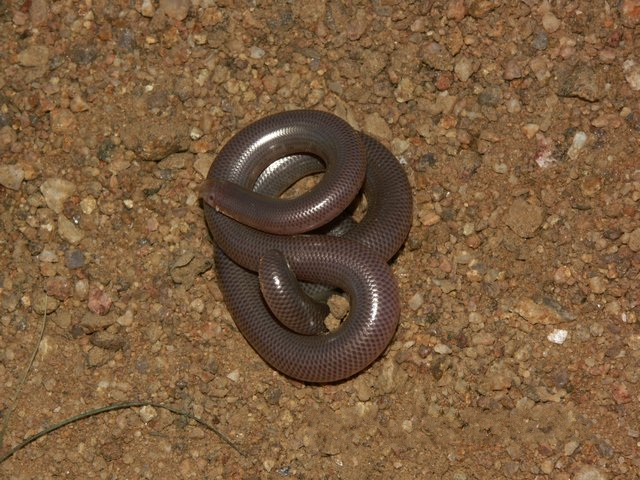Superregnum: Eukaryota
Regnum: Animalia
Subregnum: Eumetazoa
Cladus: Bilateria
Cladus: Nephrozoa
Superphylum: Deuterostomia
Phylum: Chordata
Cladus: Craniata
Subphylum: Vertebrata
Infraphylum: Gnathostomata
Superclassis: Tetrapoda
Cladus: Reptiliomorpha
Cladus: Amniota
Classis: Reptilia
Cladus: Eureptilia
Cladus: Romeriida
Subclassis: Diapsida
Cladus: Sauria
Infraclassis: Lepidosauromorpha
Superordo: Lepidosauria
Ordo: Squamata
Subordo: Serpentes
Superfamilia: Typhlopoidea
Familia: Typhlopidae
Subfamilia: Afrotyphlopinae
Genus: Rhinotyphlops
Species: Rhinotyphlops lalandei
Name
Rhinotyphlops lalandei (Schlegel, 1839)
Syntypes (9): MNHN 1492, ♂, MNHN 3214, ♂, MNHN 3214A, ♀, MNHN 6992–92A, and RMNH 3715a–d, collected by P.A. Delalande & H.B. van Horstolk between 1818–1820.
Type locality: “Vorgebirge der guten Hoffnung”.
Combinations
Typhlops lalandei Schlegel, 1839: 38 [original combination]
Rhinotyphlops lalandii [sic] — Fitzinger, 1843: 24 [subsequent combination]
Onychocephalus delalandii — Duméril & Bibron, 1844: 273 [subsequent combination]
Onychophis lalandii — Gray, 1845: 132 [subsequent combination]
References
Primary references
Schlegel, H. 1839. Abbildungen neuer oder unvollständig bekannter Amphibien, nach der Natur oder dem Leben entworfen und mit einem erläuternden Texte begleitet. Arne and Co.: Düsseldorf. xiv + 141 pp.
Links
Uetz, P. & Hallermann, J. 2022. Rhinotyphlops lalandei. The Reptile Database. Accessed on 3 January 2019.
Vernacular names
English: Delalande's Beaked Blind Snake
Rhinotyphlops lalandei, known commonly as Delalande's beaked blind snake, is a species of snake in the family Typhlopidae. The species is endemic to southern Africa.
Etymology
The specific name, lalandei, is in honor of French naturalist Pierre Antoine Delalande.[2]
Description
R. lalandei is a slender, pinkish-grey, blind snake, which has a pointed nose that it uses for burrowing.
It may attain a maximum snout-vent length (SVL) of 35 cm (13+3⁄4 in). The scales are arranged in 26-30 rows around the body. There are more than 300 dorsal scales in the vertebral row.[3]
The nostrils are located below the sharp horizontal cutting edge of the snout. The diameter of the body goes 35 to 50 times into the total length. The tail is as broad as long, or broader than long, ending in a spine.[4]
Geographic range
R. lalandei occurs throughout the eastern half of Southern Africa, as far south as Cape Town and with isolated populations in western parts such as Namibia.[5][6]
Habitat
R. lalandei can be found in a variety of habitats including semidesert, savannah, coastal bush, and fynbos.[3]
Reproduction
The species R. lalandei is oviparous. The female lays a clutch of 2-4 eggs. The hatchlings are flesh-colored.[3]
References
"Rhinotyphlops lalandei ". The Reptile Database. www.reptile-database.org
Beolens, Bo; Watkins, Michael; Grayson, Michael (2011). The Eponym Dictionary of Reptiles. Baltimore: Johns Hopkins University Press. xiii + 296 pp. ISBN 978-1-4214-0135-5. (Rhinotyphlops lalandei, p. 149).
Branch, Bill (2004). Field Guide to Snakes and other Reptiles of Southern Africa. Third Revised edition, Second impression. Sanibel Island, Florida: Ralph Curtis Books. ISBN 0-88359-042-5. (Rhinotyphlops lalandei, p. 53 + Plate 39).
Boulenger GA (1893). Catalogue of the Snakes in the British Museum (Natural History). Volume I., Containing the Families Typhlopidæ ... London: Trustees of the British Museum (Natural History). (Taylor and Francis, printers). xiii + 448 pp. + Plates I-XXVIII. (Typhlops delalandii, p. 45).
McDiarmid RW, Campbell JA, Touré T (1999). Snake Species of the World: A Taxonomic and Geographic Reference, Volume 1. Washington, District of Columbia: Herpetologists' League. 511 pp. ISBN 1-893777-00-6 (series). ISBN 1-893777-01-4 (volume).
"Rhinotyphlops". Integrated Taxonomic Information System. Retrieved 29 August 2007.
Further reading
Schlegel H (1839). Abbildungen neuer oder unvollständig bekannter Amphibien, nach der Natur oder dem Leben entworfen und mit einem erläuternden Texte begleitet. Düsseldorf: Arne & Co. xiv + 141 pp. (Typhlops lalandei, new species, p. 38). (in German).
Retrieved from "http://en.wikipedia.org/"
All text is available under the terms of the GNU Free Documentation License


